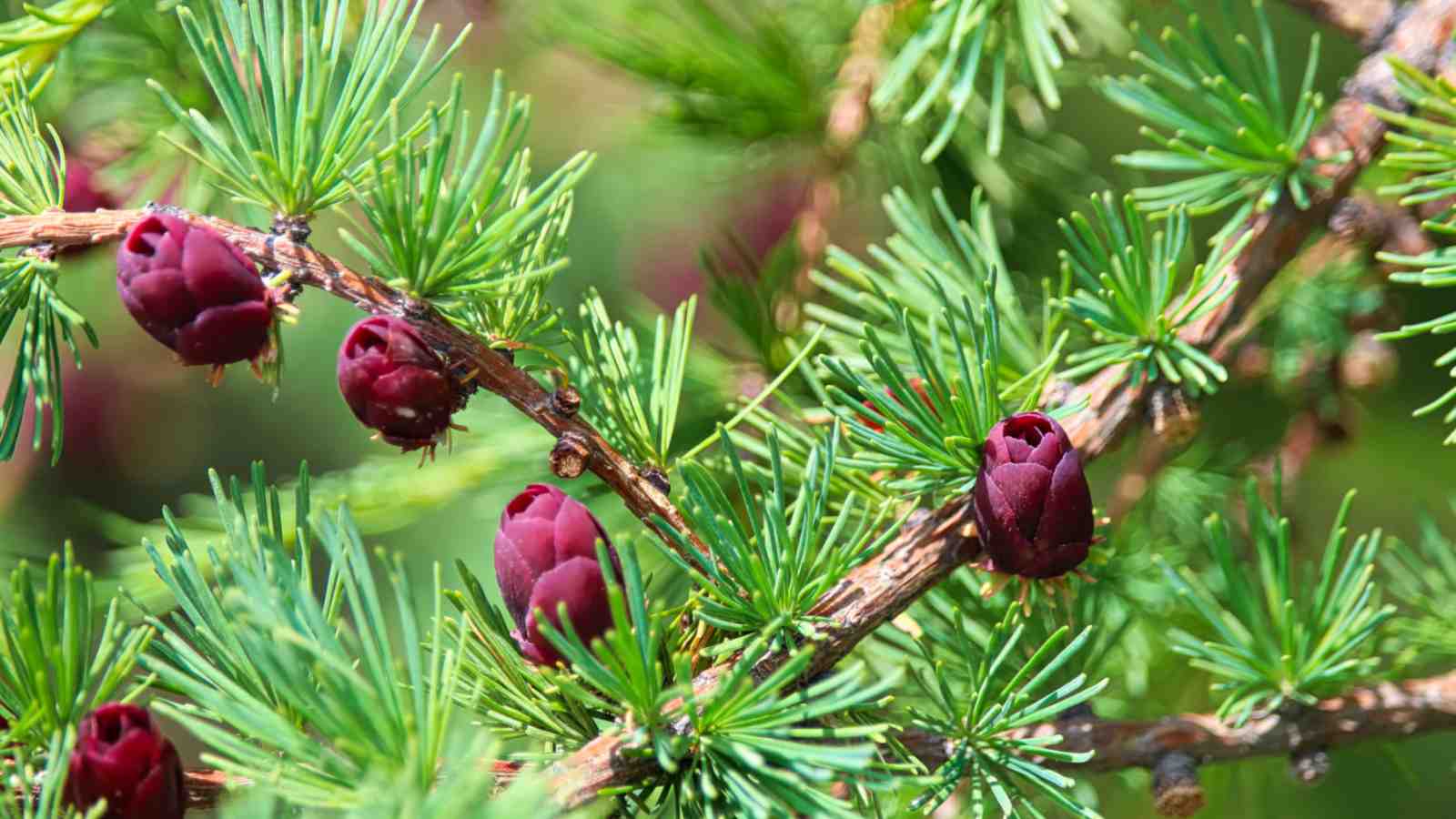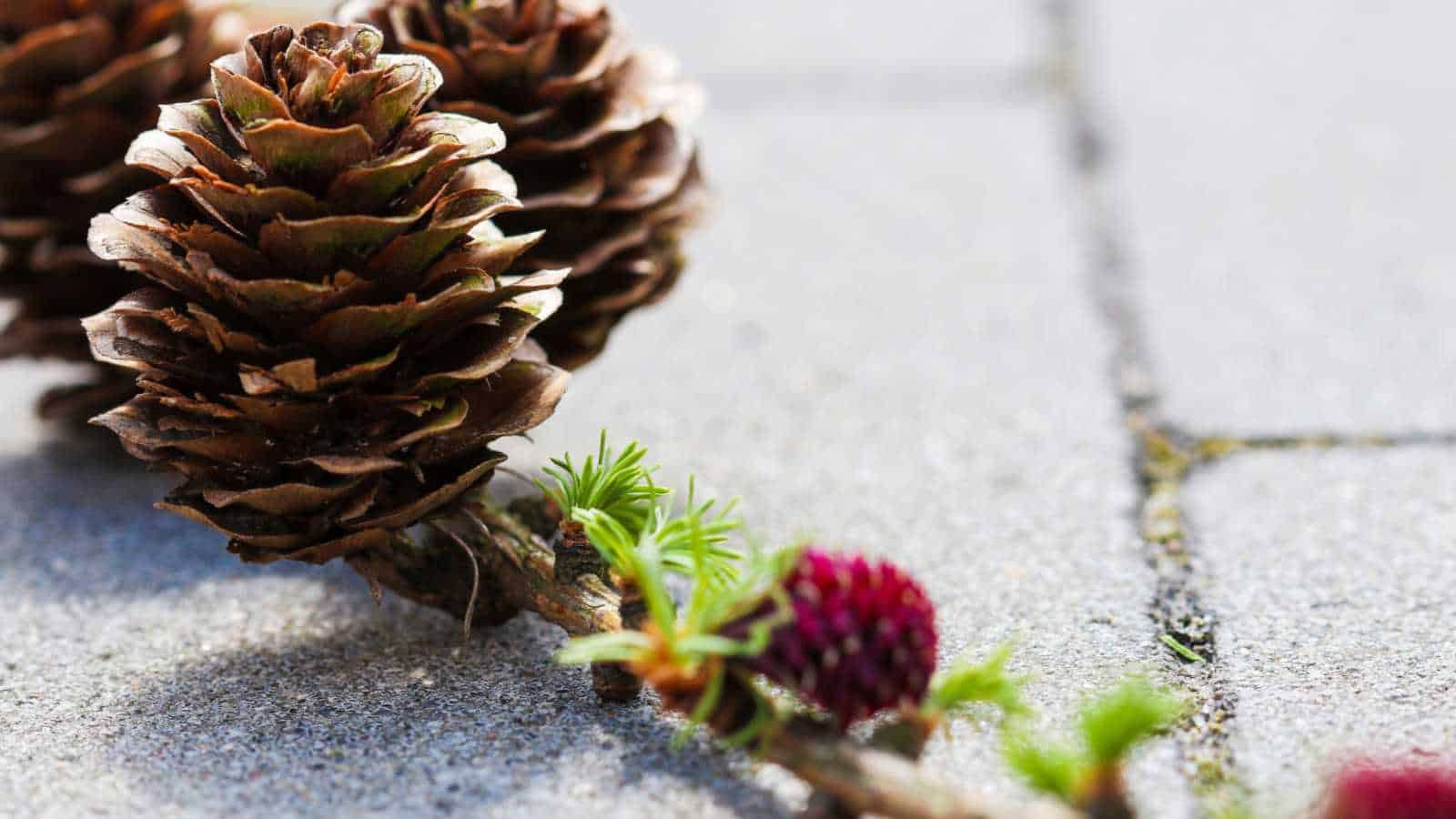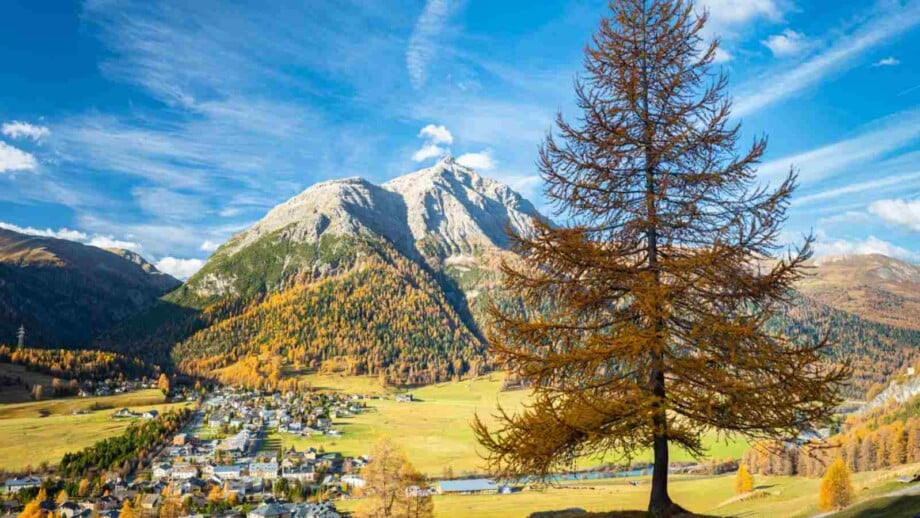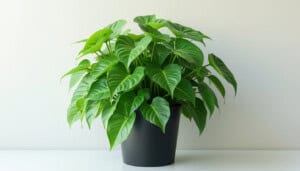Have you ever gazed upon a majestic forest and wondered about the towering giants that make it so enchanting? Today, we’re delving into the world of one such remarkable tree – the Larch. From its unique characteristics to its diverse types, native habitats, and surprising uses, we’ll unlock the secrets of this splendid coniferous tree.
The Larch, scientifically known as Larix, stands as a symbol of resilience in the world of trees. Belonging to the Pine Family, it shares kinship with fellow larches and firs, spruces, pines, and hemlocks. Its unique characteristic among conifers distinguishes it – it sheds its needles like deciduous trees, unlike their evergreen cousins.
Come autumn, the Larch boasts a breathtaking display of golden-yellow needles before shedding them for the winter. These needles are soft to the touch and arranged in clusters, creating a feathery appearance. Larch trees are known for their incredible height, often soaring to more than 100 feet, reaching for the skies. Their rugged and furrowed bark gives them a distinctive, weathered look that speaks of their age and wisdom.
Larches are a diverse bunch, with around ten recognized species. The most common ones include the European Larch (Larix decidua), Japanese Larch (Larix kaempferi), and the Western Larch (Larix occidentalis). These species can be found in various parts of the world. European Larches flourish in the mountains of Europe, while Japanese Larches are native to Japan and parts of China. Western Larches, on the other hand, grace the landscapes of North America. Each type of Larch adapts to its specific environment, displaying unique characteristics that make them a vital part of their ecosystems.

Beyond their stunning aesthetics, Larch trees offer a treasure trove of practical uses. Historically, their wood has been highly prized for its durability and resistance to rot, making it a popular choice for building structures, especially in maritime regions. Additionally, the inner bark of Larches has been utilized for its medicinal properties in traditional Native American and Asian medicine. It’s believed to have healing qualities, particularly in treating coughs and colds. This versatile tree has even found its way into the world of landscaping, adding charm and elegance to gardens and parks.
In many cultures, the Larch holds a special place. Native American tribes like the Nez Perce have revered the Western Larch for its wood and medicinal uses. In Europe, the European Larch is celebrated for its beauty and the role it plays in alpine landscapes. Furthermore, the Larch has made its mark in literature and art, often symbolizing transformation and rebirth due to its deciduous nature. It’s a reminder that even in the harshest winters, new life and growth can emerge.
Having spent decades as a master gardener, my fascination with larch trees has led me to in-depth research and hands-on experience. In this concise guide, I’ll provide essential insights into Larch trees, their characteristics, and valuable care tips for successful cultivation.

Botanical Name: Larix spp.
Common Name: Larch
Family: Pinaceae
Plant Type: Deciduous Conifer
Hardiness Zones: Zones 2 to 6, depending on the species
Sun Exposure: Full sun to partial shade
Soil Type: Well-drained, loamy soil
Soil pH: Slightly acidic to neutral (pH 6.0 to 7.0)
Maturity: 20 to 50 years
Height: Can range from 30 to over 100 feet, depending on the species
Spacing: 20 to 30 feet apart
Leaves: Needle-like leaves
Leaf Color: Golden-yellow
Bark Color: Reddish-brown, gray
Female Cones: Small, erect, 1-9 cm long, purple or green, turns to brown when ripe
Seeds: Winged
Native Area: North America, Europe, Asia, and parts of Russia
Larch Tree Care
Caring for Larch trees is essential to ensure their health and vitality, whether you have one as a prized specimen in your garden or as part of a larger woodland landscape. Here are some key aspects of Larch care to keep in mind.
Larch trees thrive in full sun to partial shade, so plant them in a location that receives adequate sunlight. As for soil, they prefer well-drained, loamy soil with slightly acidic to neutral pH levels. Ensuring proper soil conditions will help your Larch tree establish strong roots.
While Larch trees are generally hardy, they appreciate consistent moisture, especially during their early years. Adequate watering during dry spells, especially in the first few years after planting, can significantly benefit their growth.

Pruning Larch trees should be minimal. Remove any dead or damaged branches to maintain the tree’s health and appearance. Larch trees naturally shed some lower branches as they grow, so be prepared for this natural pruning process.
Applying a layer of organic mulch around the base of your Larch tree can help retain soil moisture, regulate soil temperature, and reduce competition from weeds. Just keep the mulch away from the tree’s trunk to prevent rot.
Larch trees are relatively resistant to pests and diseases, but monitoring them for any signs of trouble is essential. Look for common issues like aphids or needle-cast diseases and take appropriate measures.
Generally, mature Larch trees do not require regular fertilization. However, if you notice signs of nutrient deficiency, such as yellowing needles, you can apply a slow-release, balanced fertilizer in early spring.
In regions with high deer populations, protecting young Larch trees from deer browse is crucial. Consider using fencing or repellents to prevent damage to the tender new growth.
Light
Larch trees thrive when they receive ample sunlight, preferably in a location with full sun exposure. Much like cherry blossom trees that dazzle with their delicate blooms, Larches, too, benefit from soaking up the sun’s rays.
For Larch trees, the magic number is around six hours of direct sunlight per day. This generous dose of sunlight ensures they can photosynthesize efficiently, supporting healthy growth and foliage. However, Larches are adaptable and can tolerate partial shade, especially in regions where the intensity of the afternoon sun might be a bit too much.

Planting your Larch tree in a spot that receives plenty of sunlight encourages robust growth and helps ward off common pests and diseases. Adequate sun exposure aids in drying out the foliage after rain, reducing the risk of issues like fungal diseases. So, whether you’re nurturing a European Larch or a Japanese Larch, give them the light they need to flourish and thrive.
Soil
Larches thrive in well-drained soil that balances moisture retention and proper drainage. The ideal soil for Larch trees ensures the roots stay healthy and hydrated without being waterlogged.
Like their coniferous counterparts, Larch trees appreciate soil with a slightly acidic to neutral pH. This pH range provides the optimal conditions for nutrient absorption and overall growth. Ensuring the soil acidity is within this range can significantly benefit the health of your Larch tree.
Water
Like many other tree species, larch trees rely on a consistent water supply to flourish. It’s essential to strike a balance with watering, as excessive moisture can lead to issues such as root rot. During periods of drought or in the absence of regular rainfall, it’s crucial to provide supplementary watering to keep the soil consistently moist. This becomes especially important during the early stages of growth when Larch trees are establishing their root systems.
Conversely, you can reduce watering frequency in cooler months or during seasons with lower water demand. Larch trees exhibit remarkable resilience, but maintaining a steady moisture supply is essential to achieve optimal growth and health.
Temperature and Humidity
Renowned for their adaptability, these trees can thrive across various temperature zones, making them a versatile addition to various landscapes. While they flourish in full sun and well-drained soil, they also demonstrate resilience in cooler zones, typically within Zones 2 to 6, depending on the specific species.

For Larch trees, early spring is a pivotal time when they burst into life with their vibrant green foliage. This season is when they display their distinctive charm, especially with the emergence of fresh needles. Unlike some tree species, Larches are not highly sensitive to humidity levels. However, they do have a consistent need for moisture to ensure their health and vitality.
In prolonged drought or dry spells, it’s essential to provide supplementary watering to maintain the delicate balance of moisture that Larch trees require to thrive. Adequate watering, especially during the early stages of growth, helps these trees establish strong root systems and ensures their long-term well-being.
To further support your Larch tree in varying temperatures, it’s a good practice to apply a layer of mulch around the base of the tree. Mulch acts as an insulator, helping to regulate soil temperature and retain moisture. This protective measure can be particularly beneficial during extreme temperature fluctuations.
Fertilizer
The nutritional needs of Larch trees are relatively modest, but providing the right balance of nutrients can contribute to their overall vigor and well-being. These trees tend to thrive in well-drained soil rich in organic matter, which naturally provides some essential nutrients. Here are some guidelines for fertilizing Larch trees.
For optimal growth, applying a slow-release, balanced fertilizer in early spring is advisable. This timing aligns with the period when Larch trees prepare for new growth, ensuring they have the nutrients necessary for a healthy start to the season.
To further enrich the soil around your Larch tree and ensure it receives a steady supply of micronutrients, consider using a layer of organic mulch. Mulch helps maintain soil moisture and gradually breaks down, releasing nutrients into the soil.
While providing the right nutrients is beneficial, it’s important not to over-fertilize Larch trees. Excessive fertilizer application can lead to various problems, including leaf diseases like needle cast and susceptibility to pests. Therefore, balancing and refraining from excessive or heavy-handed fertilization is crucial.

Pruning
When it comes to pruning Larch trees, a light touch is often the best approach, especially during their early years. Larch trees typically require minimal pruning to maintain their natural beauty and health.
Timing is crucial when considering pruning for Larch trees. It’s advisable to perform any necessary pruning during the dormant season, preferably in late winter or early spring before new growth begins. Pruning during this time helps the tree conserve its energy and minimize stress.
One essential consideration when pruning Larch trees is to avoid the removal of too many branches, as excessive pruning can stress the tree and make it more susceptible to diseases and pests. Focus on removing dead or damaged branches and any crossing or rubbing against each other. This will not only improve the tree’s overall health but also enhance its aesthetic appeal.
Overwintering
While Larch trees are hardy, some precautions can help them thrive during the colder months.
One key practice in overwintering Larch trees is applying a layer of mulch around the base of the tree. This layer of mulch serves multiple purposes, including providing extra warmth to the root zone and helping to retain moisture. By insulating the roots, mulch can safeguard them from extreme cold and temperature fluctuations, promoting the tree’s overall well-being.
Maintaining well-drained soil is another crucial aspect of overwintering Larch trees. Even in winter, it’s important to ensure that the soil around the tree remains well-drained. This helps prevent issues like root rot, which can occur when roots are exposed to excessive moisture for extended periods.

In regions where winters are particularly severe, additional protective measures such as wrapping the tree or providing windbreaks may be considered to shield Larch trees from extreme cold and drying winds.
Types of Larch Tree
Larch trees come in various captivating cultivars, each with its unique characteristics. Let’s explore some of these distinct varieties:
North American Species:
Eastern Larch or Tamarack (Larix laricina)

Eastern Larch, also known as Tamarack and American Larch, is a North American species. It is a deciduous conifer and is recognized for its ability to thrive in wetland areas. The needles of Eastern Larch turn a brilliant golden-yellow in the fall before shedding.
Subalpine Larch (Larix lyallii)

Subalpine Larch is native to North America and is often found in mountainous regions. This species features delicate needles that turn golden in autumn, creating a striking visual display. Their habitat ranges from the Wenatchee Mountains in the south to British Columbia and Alberta in the north, and it extends eastward to encompass northern Idaho and western Montana.
Western Larch (Larix occidentalis)

Western Larch is a tall and robust tree native to North America. It is highly prized for its durable wood used in construction. The needles of Western Larch also turn golden in the fall. Their distribution spans from Oregon to British Columbia and extends eastward through Idaho into northwestern Montana.
Eurasian Species:
European Larch (Larix decidua)

European Larch is a species from Eurasia. It boasts soft, light-green needles that transform into a brilliant golden-yellow in autumn. This cultivar is widely appreciated for its ornamental value.
Siberian Larch (Larix sibirica)

Native to Siberia and other parts of Asia, the Siberian Larch is known for its slender, straight trunk and blue-green needles that turn golden-yellow in the fall. It is particularly valued for timber production and reforestation efforts.
Dahurian Larch (Larix gmelinii)

Dahurian Larch is another Eurasian species. It shares characteristics with other Larches, including slender branches and golden-yellow needles in the fall.
Japanese Larch (Larix kaempferi)

Native to Japan, the Japanese Larch stands out with its slender, upright growth and finely textured needles. Its needles transition to a vibrant yellow-orange hue in the fall, making it a popular choice for landscaping.
Chinese Larch (Larix potaninii)

Chinese Larch is found in southern regions and exhibits long-bracted cones. Its adaptability to various conditions makes it a valuable addition to landscapes.
Master’s Larch (Larix mastersiana)
Master’s Larch is native to southern regions and is known for its long bracts on its cones. It thrives in challenging growing conditions and contributes to diverse ecosystems.
Himalayan Larch (Larix griffithii)

Himalayan Larch, as the name suggests, is native to the Himalayas. It is another long-bracted species with unique features that make it well-suited to its native habitat.
Each of these Larch cultivars offers its unique beauty and attributes, making them valuable additions to a wide range of landscapes and applications. Whether you seek stunning fall foliage, reliable timber production, or adaptability to specific geographic regions, there’s a Larch cultivar to suit your needs.
How to Plant Larch Tree From Seed
Larches are exceptionally straightforward to propagate from seeds, boasting a significant germination success rate. The only aspect to remember is that they exhibit a lengthy germination period. In this guide, we’ll walk you through each step to ensure your seed-to-tree journey is a success.
Step 1: Preparing the Seed
To kickstart your journey, you’ll need Larch seeds. You can often find these seeds in cones that have fallen from mature Larch trees. First, collect these cones and let them dry out. Once they’ve opened up, you can extract the seeds within. Ensure the seeds are clean and free of debris.

Step 2: Planting the Seed
When planting Larch seeds, creating the right environment is essential. Use well-draining soil in a container or nursery bed. Plant the seeds about half an inch deep in the soil, ensuring they’re spaced apart to allow room for growth. Cover them gently with soil and pat it down lightly to ensure good seed-to-soil contact.
Step 3: Providing the Right Conditions
Larch trees thrive in full sun, so make sure your seedlings receive plenty of direct sunlight. Keep the soil consistently moist but not waterlogged. Overwatering can lead to root rot, so strike a balance. As your seedlings grow, be prepared to transplant them into larger containers or into the ground, providing adequate spacing.
Step 4: Addressing Common Pests and Problems
Like all plants, Larch trees may face challenges. Keep an eye out for common pests such as aphids or sawfly larvae. Consider natural remedies or consult a local nursery for guidance if you notice any issues. Ensuring proper air circulation and avoiding overcrowding can also help prevent problems.
Step 5: Cone Production and Aftercare
Larch trees typically produce cones rather than traditional flowers. However, once your Larch tree matures, it will develop these unique cones, adding to its natural charm. Regularly monitor the growth of your Larch tree and provide proper care as it matures. Prune dead or damaged branches and continue to ensure they receive adequate sunlight and water.

How to Propagate Larch Trees
Embarking on the journey of propagating Larch trees can be an immensely rewarding experience, allowing you to expand your forested landscape or share the beauty of Larches with others. In this guide, we’ll delve into the steps required to propagate Larch trees successfully, sharing tips and insights along the way.
Selecting a Proper Specimen
To begin your propagation adventure, start by selecting a healthy and robust Larch tree as your source specimen. Look for a tree with vibrant foliage, free from any visible signs of disease or stress. Choosing a strong parent tree is a crucial foundation for the success of your propagation efforts.
Cutting Preparation
With your parent tree selected, it’s time to prepare cuttings. Opt for semi-hardwood cuttings, typically taken during the late summer or early autumn. These cuttings should be about six inches in length, with a clean cut just below a leaf node. Remove any leaves from the lower part of the cutting to reduce water loss and encourage root development.
Rooting
To encourage rooting, place your cuttings in a well-draining, sterile rooting medium, such as a mix of perlite and peat moss. Maintain a consistent level of moisture in the medium and provide bottom heat or a heated propagation mat to promote root growth. Patience is key here, as Larch cuttings may take several months to develop roots.
Care and Maintenance
As your cuttings begin to root and grow, it’s essential to provide them with proper care. Keep them in a humid environment, using a plastic cover or misting system to maintain humidity levels. Ensure they receive bright, indirect light to support photosynthesis while avoiding direct sunlight that can scorch the delicate new growth.
Finding a Suitable Location

When your propagated Larch trees have developed strong roots and are ready for transplanting, choose a suitable location in your landscape. Larches thrive in well-draining soil and full sun to partial shade. Ensure proper spacing to allow for their mature size, as these trees can grow tall and wide.
Monitoring for Pests and Diseases
Regularly monitor your young Larch trees for any signs of pests or diseases. Aphids and needle cast diseases are common issues that can affect Larches. Early detection and prompt action can prevent these problems from spreading and harming your trees.
Common Uses of Larch Trees
Larch trees, with their majestic presence and unique characteristics, offer a multitude of uses and value to both natural ecosystems and human activities. Let’s explore some of the significant roles they play in our world.
Aesthetic and Ornamental Value
One of the foremost values of Larch trees lies in their aesthetic and ornamental appeal. Their striking deciduous habit sets them apart from most conifers, as they shed their needles in the fall, creating a brilliant display of golden foliage. Landscapers and garden enthusiasts often include Larch trees to add visual interest and a burst of vibrant color to gardens, parks, and public spaces. Their graceful form and seasonal beauty make them a prized addition to any landscape.
Timber Production
Renowned for its high-quality timber, the wood of Larch trees is strong, durable, and naturally resistant to decay, making it a preferred choice for various construction purposes. From building homes and structures to crafting outdoor furniture and decking, Larch wood is highly sought after. Its strength and longevity make it an excellent investment in construction and woodworking projects.
Wildlife Habitat and Biodiversity
Larch trees provide essential habitat and sustenance for a variety of wildlife species. Birds, such as crossbills and red squirrels, feed on Larch seeds found within the tree’s cones. These trees also offer shelter and nesting sites for birds and small mammals. Additionally, Larch forests contribute to maintaining healthy soil and water ecosystems, supporting a diverse range of plant and animal life.
Cultural Significance
In some cultures, Larch trees hold cultural and historical significance. For instance, in Siberia, the Siberian Larch is not only a source of timber but also has spiritual importance to indigenous communities. In regions where Larch trees are native, they often feature in folklore, traditional medicine, and ceremonies, highlighting their deep cultural connections.
Soil Stabilization
Larch trees play a vital role in soil stabilization, particularly in regions with challenging terrain or steep slopes. Their extensive root systems help prevent soil erosion, reducing the risk of landslides and soil degradation. Planting Larch trees in vulnerable areas can help safeguard landscapes and prevent environmental hazards.
Reforestation and Carbon Sequestration
These trees are also commonly used in reforestation efforts due to their adaptability and fast growth. Planting Larch in deforested or degraded areas helps restore ecosystems and combat deforestation. Furthermore, like all trees, Larch trees absorb carbon dioxide from the atmosphere, making them valuable allies in mitigating climate change by sequestering carbon.

Common Pests and Plant Diseases for Larch Trees
Larch trees, with their unique beauty and resilience, are not immune to the challenges posed by common pests and plant diseases. As a tree enthusiast, it’s crucial to be well-informed about these potential adversaries and how to address them effectively. Let’s dive into some of the frequent culprits and the strategies to protect your Larch trees.
Needle Cast Diseases
One common ailment that can affect Larch trees is needle cast diseases. These fungal diseases often manifest as discolored and damaged needles, which can be disheartening for tree enthusiasts. The key to managing needle cast diseases is to maintain good air circulation around your trees. Avoid planting Larch trees too closely together, as overcrowding can create a humid environment conducive to fungal growth. Additionally, consider applying fungicides at the appropriate times in the spring to prevent these diseases from taking hold.
Aphid Infestations

Aphids, those tiny, sap-sucking insects, can also pose a threat to Larch trees. These pests can cause damage by feeding on the tree’s tender shoots and leaves, often leading to curling, yellowing, and distorted growth. To combat aphid infestations, encourage natural predators like ladybugs, lacewings, or parasitic wasps that can help keep aphid populations in check. If necessary, you can use insecticidal soaps or neem oil to control aphids while minimizing harm to beneficial insects.
Root Rot
Root rot is a fungal disease that affects the root system of Larch trees. It often results from overly wet or waterlogged soil. To prevent root rot, ensure your Larch trees are planted in well-draining soil. Avoid overwatering, especially during periods of heavy rainfall or in poorly drained areas. Proper soil drainage and prudent watering practices are your best allies in keeping root rot at bay.
Caterpillar Defoliation
Larch trees can also fall victim to hungry caterpillars that defoliate their branches. While it may be disheartening to see your tree’s foliage disappearing, it’s essential to act promptly. Inspect your Larch tree for caterpillar presence, and if detected, consider using insecticidal sprays to control their numbers. Additionally, attracting birds to your garden can be a natural way to manage caterpillar populations.
Larch Sawfly

The Larch Sawfly is another potential pest that can threaten your Larch trees. These insects feed on the needles of the tree, causing defoliation. To manage Larch Sawfly infestations, inspect your trees regularly and prune affected branches. Consider using insecticidal sprays or introducing natural predators like parasitic wasps to keep these sawflies in check.
Larch Case-Bearer
The Larch Case-Bearer is a tiny moth whose larvae feed on Larch needles while residing in protective cases. To control Larch Case-Bearer infestations, monitor your trees for signs of damage and consider removing and destroying the affected cases. Pruning can also help remove infested branches.
Other Tree Guides from Planet Natural:
Spruce Tree Complete Guide: Growing, Caring, Types and Uses
How to Grow and Care for Japanese Yew Trees (Complete Guide)











